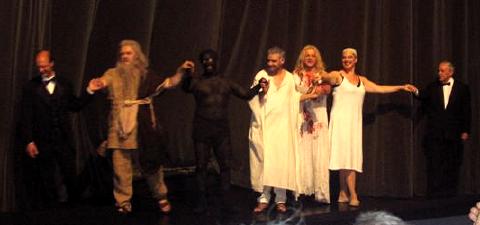|
<< -- 7 -- Malcolm Miller THE BAYREUTH EXPERIENCE

The Great Hall of the Grail evoked a sense of depth and scale enhanced with hanging sheets and projections, movable objects and the spinning stage around which the knights of the Grail walked, here depicted as representatives from all world religions. The symbolism was fuzzy, at once a notion of all religions as a large secret society guarding the grail (suggesting perhaps The Priory of Sion in Dan Brown's novel), the key to power. Schlingensief's universalising linked with the notion of Christian grail only nominally; the tribal blood rite serving as a replacement for the communion yet with different results. With the large projected images of dead rabbits and other animals, it was a reference to contemporary sacrificial practices, through which purity is attained: here Parsifal, who enters pure and comes out stained with blood. This seemed in touch with the essence of the grail scene without its specificity, and in tune with the grandeur of the music. However the critique of religions was not made sufficiently metaphorical since the ritual presented was too specific. Furthermore it was rather marred by a quite insensitive silhouetted image of a concentration camp watch tower and barbed wire, which in addition to two rather caricatured rabbis, seemed yet another miscalculation. Musically the Grail scene was impressive, with the role of Amfortas eloquently sung by Alexander Marco-Burhmester and the choruses enthralling.
Klingsor's kingdom in Act II was an elaborate fenced-in African village. This is the locus of Parsifal's awakening to knowledge, his Garden of Eden experience, and here the imagery is again taken into African art. Klingsor, John Wegner, is blacked up, one of the provocative elements of the production which, moreover, is self-consciously done as if to arouse audience interest -- Klingsor's mime-double wipes off the paint at one point. It might stand for white appropriation of the tribal mantle, a metaphor for Western art trying to find its roots, or merely a swipe at post-colonial attitudes. The political reference is that of some militia camp with Kundry held hostage along with the other girls, Klingsor's Zaubermädchen.
The production's contemporary echoes result in some fairly hefty distortions of the original plot: It is Klingsor who engineers Kundry's wounding rather than Amfortas; Parsifal is a means to that end, and so, rather than attack Parsifal, Klingsor gives him the spear with which Parsifal wounds Kundry -- a reversal of the original stage action in which Klingsor's spear fails to hit Parsifal: it remains suspended over him. Parsifal is somehow part of a new order that Klingsor has envisaged, yet Klingsor himself escapes on a sky rocket, and Parsifal takes over as deposer of Amfortas. And this is the startling ending of Act III : for whereas Parsifal is supposed to redeem and cure Amfortas, becoming himself king by consensus and anointed as such, in fact the spear is used to kill Amfortas, and Parsifal is himself killed by the assembled knights. Nothing is left at the end except the glowing grail, a shadow of a person, which suggests the cyclic recurrence of the process. There is no redemption, no new order as in the original, and it is this rather pessimistic interpretation that seemed to inspire much of the audience to boo. Might Parsifal's killing of Amfortas be a metaphor for the acceptance of his atonement and release through death, and Parsifal's self-sacrifice a type of redemption with abstracted Christian symbolism?

Pierre Boulez (right) with the solo cast of 'Parsifal'
|
Throughout it was Wagner's stunning music, magically shaped by Boulez with finesse and subtlety, that guided the production ineluctably to its denouement, with many highpoints of intense beauty. It was in some ways a performance that underlined French qualities, one which clarified strands, made harmonies transparent and which also underlined the harmonic and even orchestral anticipations of Debussy and 20th century composers. The performance thus helped one to grasp an entirely new take on the story, a type of 'fantasy on Parsifal', to sift the gratuitous from the necessary gestures, and to interpret the contemporary relevance of this stimulating if not entirely successful production.

The 'Parsifal' chorus and cast
|
Continue >>
Copyright © 25 July 2006
Malcolm Miller, London UK

|

